2017 NISSAN VERSA SEDAN steering
[x] Cancel search: steeringPage 13 of 404

1. Headlight/turn signal switch/fog lightswitch (if so equipped) (P. 2-25)
2. Driver’s supplemental air bag (P. 1-39) Horn (P. 2-28)
3. Meters and gauges (P. 2-3) Warning and indicator lights (P. 2-12)
4. Wiper and washer switch (P. 2-23)
5. Vents (P. 4-16)
6. Rear window defroster switch (P. 2-24)
7. Front passenger air bag status light
(P. 1-39)
8. Hazard warning flasher switch (P. 6-2)
9. Climate controls (P. 4-17)
10. Audio system (P. 4-25)
11. Passenger’s supplemental air bag
(P. 1-39)
12. Glove box (P. 2-30)
13. Power outlet (P. 2-29)
14. Shift lever (P. 5-17)
15. Cup holders (P. 2-30)
16. Ignition switch (if so equipped) (P. 5-8) Push-button ignition switch
(if so equipped) (P. 5-11)
17. Cruise control switches
(if so equipped) (P. 5-28)
18. Tilt steering (P. 3-30)
LII2475
INSTRUMENT PANEL
0-6Illustrated table of contents
Page 16 of 404
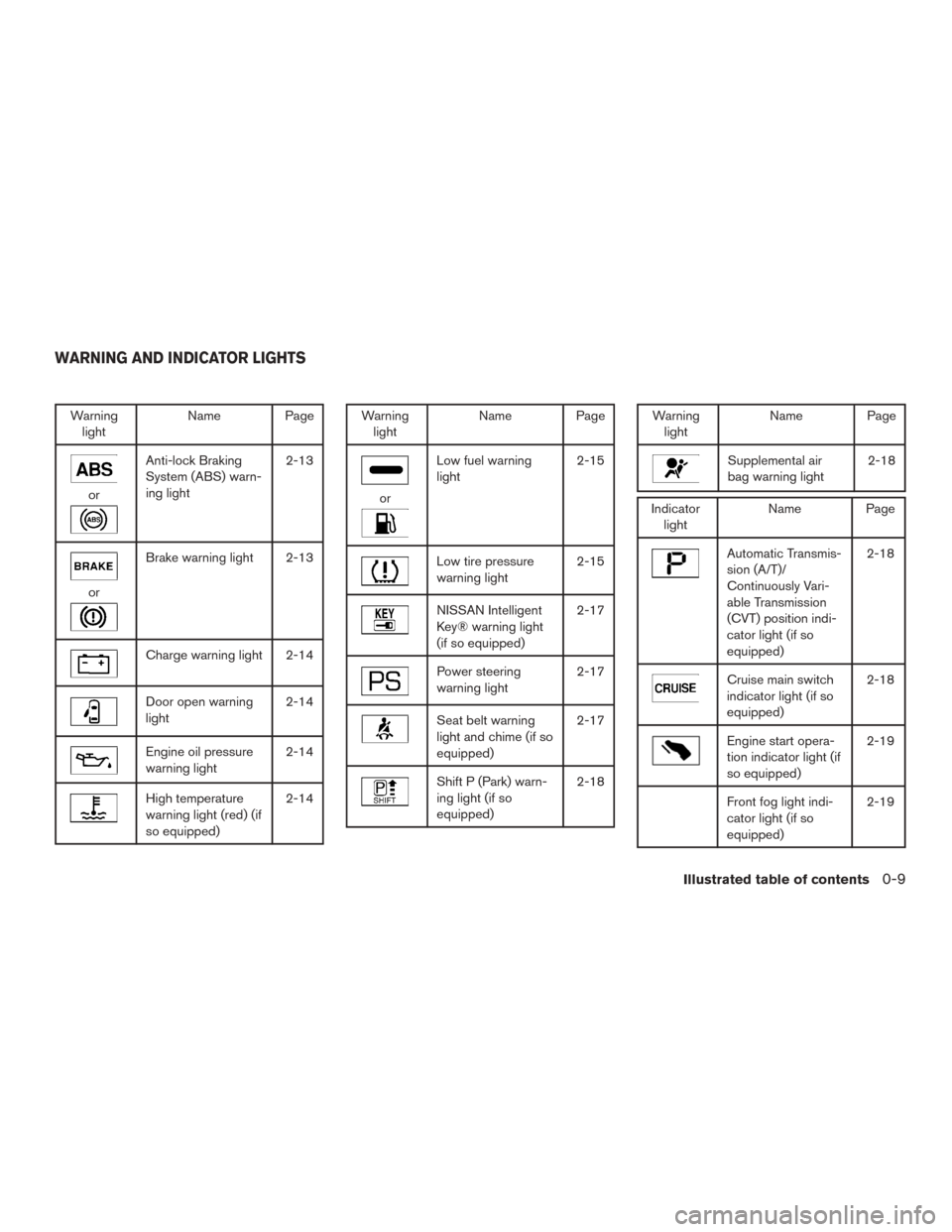
Warninglight Name Page
or
Anti-lock Braking
System (ABS) warn-
ing light 2-13
or
Brake warning light 2-13
Charge warning light 2-14
Door open warning
light
2-14
Engine oil pressure
warning light2-14
High temperature
warning light (red) (if
so equipped)2-14
Warning
light Name Page
or
Low fuel warning
light 2-15
Low tire pressure
warning light2-15
NISSAN Intelligent
Key® warning light
(if so equipped)2-17
Power steering
warning light
2-17
Seat belt warning
light and chime (if so
equipped)2-17
Shift P (Park) warn-
ing light (if so
equipped)2-18
Warning
light Name Page
Supplemental air
bag warning light 2-18
Indicator
light Name Page
Automatic Transmis-
sion (A/T)/
Continuously Vari-
able Transmission
(CVT) position indi-
cator light (if so
equipped) 2-18
Cruise main switch
indicator light (if so
equipped)
2-18
Engine start opera-
tion indicator light (if
so equipped)2-19
Front fog light indi-
cator light (if so
equipped)2-19
WARNING AND INDICATOR LIGHTS
Illustrated table of contents0-9
Page 57 of 404
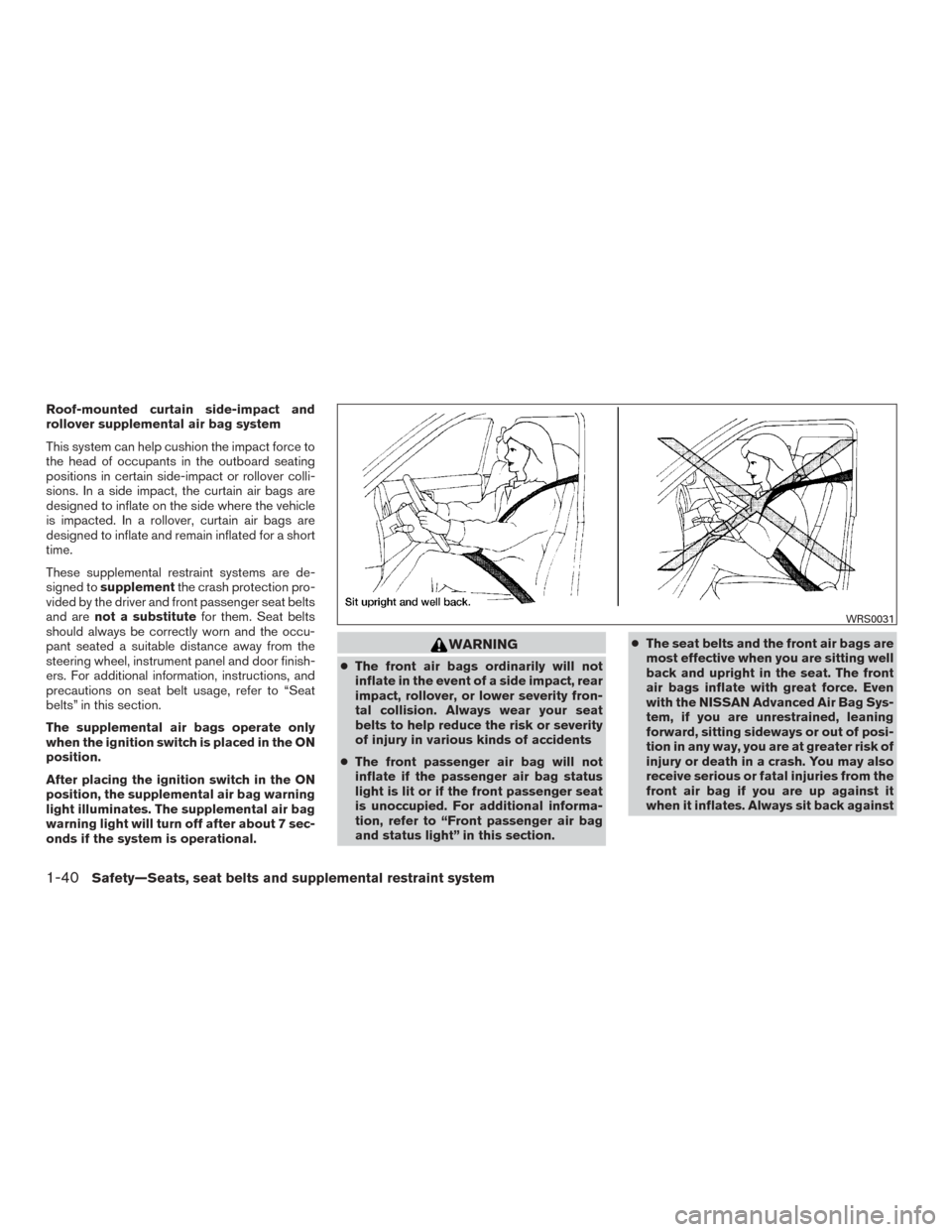
Roof-mounted curtain side-impact and
rollover supplemental air bag system
This system can help cushion the impact force to
the head of occupants in the outboard seating
positions in certain side-impact or rollover colli-
sions. In a side impact, the curtain air bags are
designed to inflate on the side where the vehicle
is impacted. In a rollover, curtain air bags are
designed to inflate and remain inflated for a short
time.
These supplemental restraint systems are de-
signed tosupplement the crash protection pro-
vided by the driver and front passenger seat belts
and are not a substitute for them. Seat belts
should always be correctly worn and the occu-
pant seated a suitable distance away from the
steering wheel, instrument panel and door finish-
ers. For additional information, instructions, and
precautions on seat belt usage, refer to “Seat
belts” in this section.
The supplemental air bags operate only
when the ignition switch is placed in the ON
position.
After placing the ignition switch in the ON
position, the supplemental air bag warning
light illuminates. The supplemental air bag
warning light will turn off after about 7 sec-
onds if the system is operational.
WARNING
● The front air bags ordinarily will not
inflate in the event of a side impact, rear
impact, rollover, or lower severity fron-
tal collision. Always wear your seat
belts to help reduce the risk or severity
of injury in various kinds of accidents
● The front passenger air bag will not
inflate if the passenger air bag status
light is lit or if the front passenger seat
is unoccupied. For additional informa-
tion, refer to “Front passenger air bag
and status light” in this section. ●
The seat belts and the front air bags are
most effective when you are sitting well
back and upright in the seat. The front
air bags inflate with great force. Even
with the NISSAN Advanced Air Bag Sys-
tem, if you are unrestrained, leaning
forward, sitting sideways or out of posi-
tion in any way, you are at greater risk of
injury or death in a crash. You may also
receive serious or fatal injuries from the
front air bag if you are up against it
when it inflates. Always sit back against
WRS0031
1-40Safety—Seats, seat belts and supplemental restraint system
Page 58 of 404
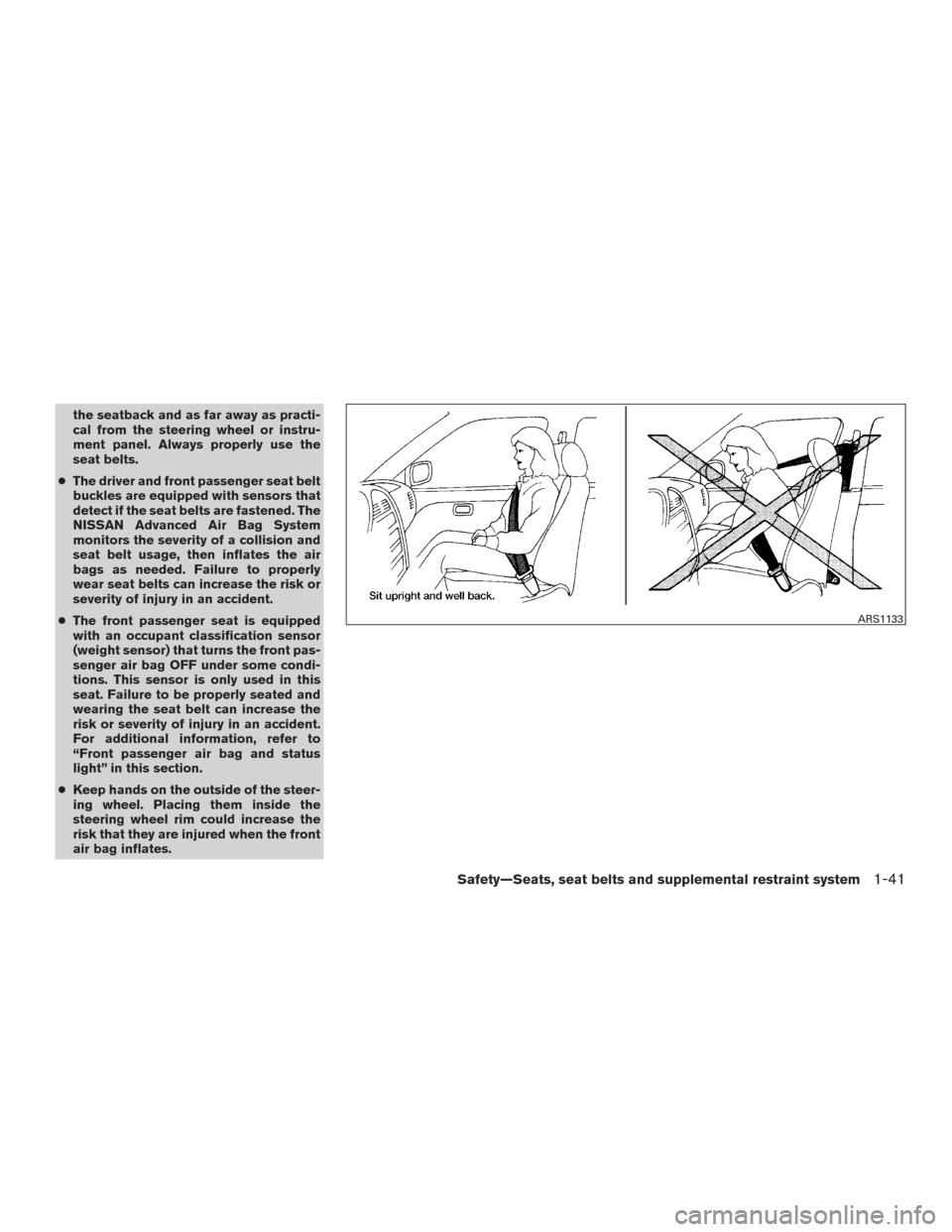
the seatback and as far away as practi-
cal from the steering wheel or instru-
ment panel. Always properly use the
seat belts.
● The driver and front passenger seat belt
buckles are equipped with sensors that
detect if the seat belts are fastened. The
NISSAN Advanced Air Bag System
monitors the severity of a collision and
seat belt usage, then inflates the air
bags as needed. Failure to properly
wear seat belts can increase the risk or
severity of injury in an accident.
● The front passenger seat is equipped
with an occupant classification sensor
(weight sensor) that turns the front pas-
senger air bag OFF under some condi-
tions. This sensor is only used in this
seat. Failure to be properly seated and
wearing the seat belt can increase the
risk or severity of injury in an accident.
For additional information, refer to
“Front passenger air bag and status
light” in this section.
● Keep hands on the outside of the steer-
ing wheel. Placing them inside the
steering wheel rim could increase the
risk that they are injured when the front
air bag inflates.
ARS1133
Safety—Seats, seat belts and supplemental restraint system1-41
Page 64 of 404
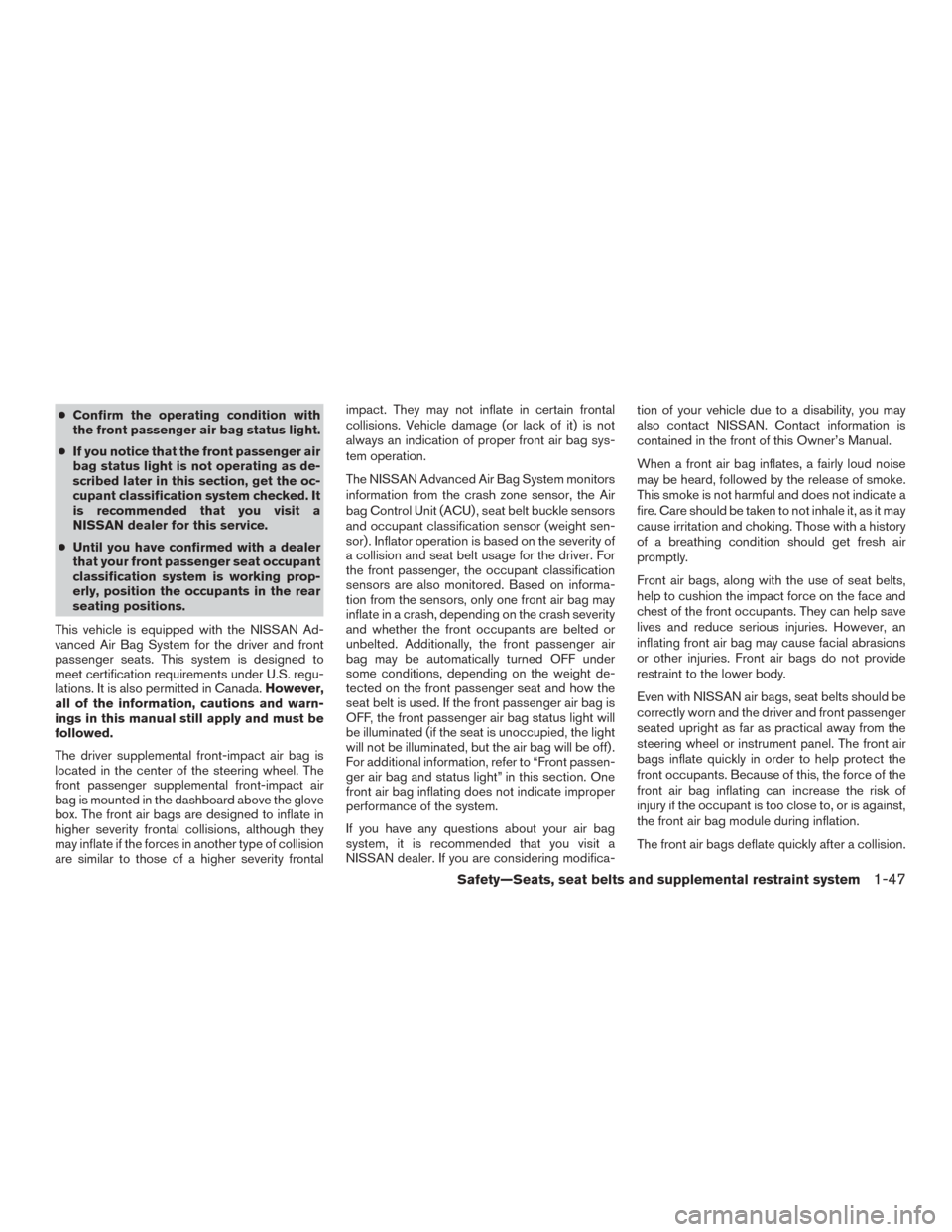
●Confirm the operating condition with
the front passenger air bag status light.
● If you notice that the front passenger air
bag status light is not operating as de-
scribed later in this section, get the oc-
cupant classification system checked. It
is recommended that you visit a
NISSAN dealer for this service.
● Until you have confirmed with a dealer
that your front passenger seat occupant
classification system is working prop-
erly, position the occupants in the rear
seating positions.
This vehicle is equipped with the NISSAN Ad-
vanced Air Bag System for the driver and front
passenger seats. This system is designed to
meet certification requirements under U.S. regu-
lations. It is also permitted in Canada. However,
all of the information, cautions and warn-
ings in this manual still apply and must be
followed.
The driver supplemental front-impact air bag is
located in the center of the steering wheel. The
front passenger supplemental front-impact air
bag is mounted in the dashboard above the glove
box. The front air bags are designed to inflate in
higher severity frontal collisions, although they
may inflate if the forces in another type of collision
are similar to those of a higher severity frontal impact. They may not inflate in certain frontal
collisions. Vehicle damage (or lack of it) is not
always an indication of proper front air bag sys-
tem operation.
The NISSAN Advanced Air Bag System monitors
information from the crash zone sensor, the Air
bag Control Unit (ACU) , seat belt buckle sensors
and occupant classification sensor (weight sen-
sor) . Inflator operation is based on the severity of
a collision and seat belt usage for the driver. For
the front passenger, the occupant classification
sensors are also monitored. Based on informa-
tion from the sensors, only one front air bag may
inflate in a crash, depending on the crash severity
and whether the front occupants are belted or
unbelted. Additionally, the front passenger air
bag may be automatically turned OFF under
some conditions, depending on the weight de-
tected on the front passenger seat and how the
seat belt is used. If the front passenger air bag is
OFF, the front passenger air bag status light will
be illuminated (if the seat is unoccupied, the light
will not be illuminated, but the air bag will be off) .
For additional information, refer to “Front passen-
ger air bag and status light” in this section. One
front air bag inflating does not indicate improper
performance of the system.
If you have any questions about your air bag
system, it is recommended that you visit a
NISSAN dealer. If you are considering modifica-
tion of your vehicle due to a disability, you may
also contact NISSAN. Contact information is
contained in the front of this Owner’s Manual.
When a front air bag inflates, a fairly loud noise
may be heard, followed by the release of smoke.
This smoke is not harmful and does not indicate a
fire. Care should be taken to not inhale it, as it may
cause irritation and choking. Those with a history
of a breathing condition should get fresh air
promptly.
Front air bags, along with the use of seat belts,
help to cushion the impact force on the face and
chest of the front occupants. They can help save
lives and reduce serious injuries. However, an
inflating front air bag may cause facial abrasions
or other injuries. Front air bags do not provide
restraint to the lower body.
Even with NISSAN air bags, seat belts should be
correctly worn and the driver and front passenger
seated upright as far as practical away from the
steering wheel or instrument panel. The front air
bags inflate quickly in order to help protect the
front occupants. Because of this, the force of the
front air bag inflating can increase the risk of
injury if the occupant is too close to, or is against,
the front air bag module during inflation.
The front air bags deflate quickly after a collision.
Safety—Seats, seat belts and supplemental restraint system1-47
Page 69 of 404
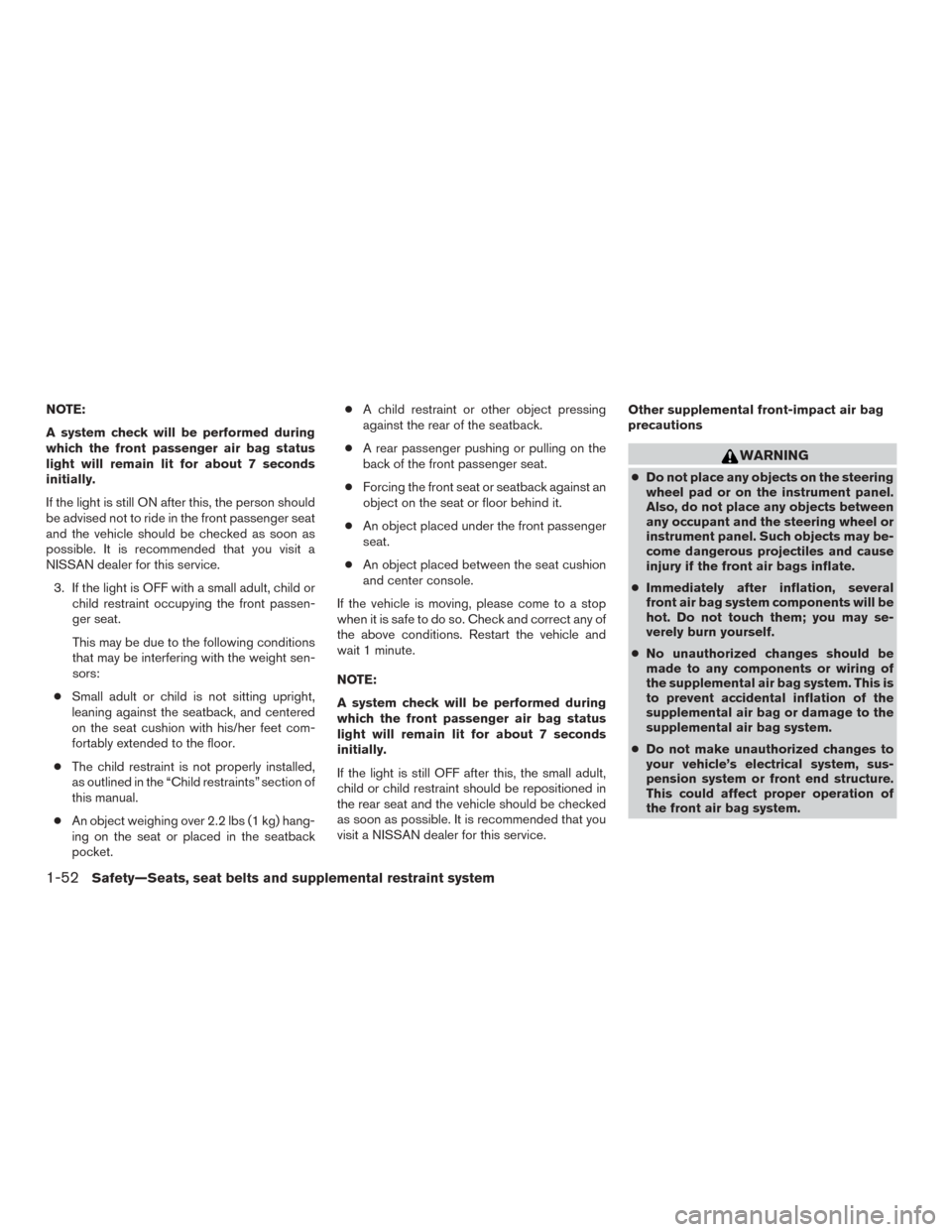
NOTE:
A system check will be performed during
which the front passenger air bag status
light will remain lit for about 7 seconds
initially.
If the light is still ON after this, the person should
be advised not to ride in the front passenger seat
and the vehicle should be checked as soon as
possible. It is recommended that you visit a
NISSAN dealer for this service.3. If the light is OFF with a small adult, child or child restraint occupying the front passen-
ger seat.
This may be due to the following conditions
that may be interfering with the weight sen-
sors:
● Small adult or child is not sitting upright,
leaning against the seatback, and centered
on the seat cushion with his/her feet com-
fortably extended to the floor.
● The child restraint is not properly installed,
as outlined in the “Child restraints” section of
this manual.
● An object weighing over 2.2 lbs (1 kg) hang-
ing on the seat or placed in the seatback
pocket. ●
A child restraint or other object pressing
against the rear of the seatback.
● A rear passenger pushing or pulling on the
back of the front passenger seat.
● Forcing the front seat or seatback against an
object on the seat or floor behind it.
● An object placed under the front passenger
seat.
● An object placed between the seat cushion
and center console.
If the vehicle is moving, please come to a stop
when it is safe to do so. Check and correct any of
the above conditions. Restart the vehicle and
wait 1 minute.
NOTE:
A system check will be performed during
which the front passenger air bag status
light will remain lit for about 7 seconds
initially.
If the light is still OFF after this, the small adult,
child or child restraint should be repositioned in
the rear seat and the vehicle should be checked
as soon as possible. It is recommended that you
visit a NISSAN dealer for this service. Other supplemental front-impact air bag
precautions
WARNING
●
Do not place any objects on the steering
wheel pad or on the instrument panel.
Also, do not place any objects between
any occupant and the steering wheel or
instrument panel. Such objects may be-
come dangerous projectiles and cause
injury if the front air bags inflate.
● Immediately after inflation, several
front air bag system components will be
hot. Do not touch them; you may se-
verely burn yourself.
● No unauthorized changes should be
made to any components or wiring of
the supplemental air bag system. This is
to prevent accidental inflation of the
supplemental air bag or damage to the
supplemental air bag system.
● Do not make unauthorized changes to
your vehicle’s electrical system, sus-
pension system or front end structure.
This could affect proper operation of
the front air bag system.
1-52Safety—Seats, seat belts and supplemental restraint system
Page 70 of 404
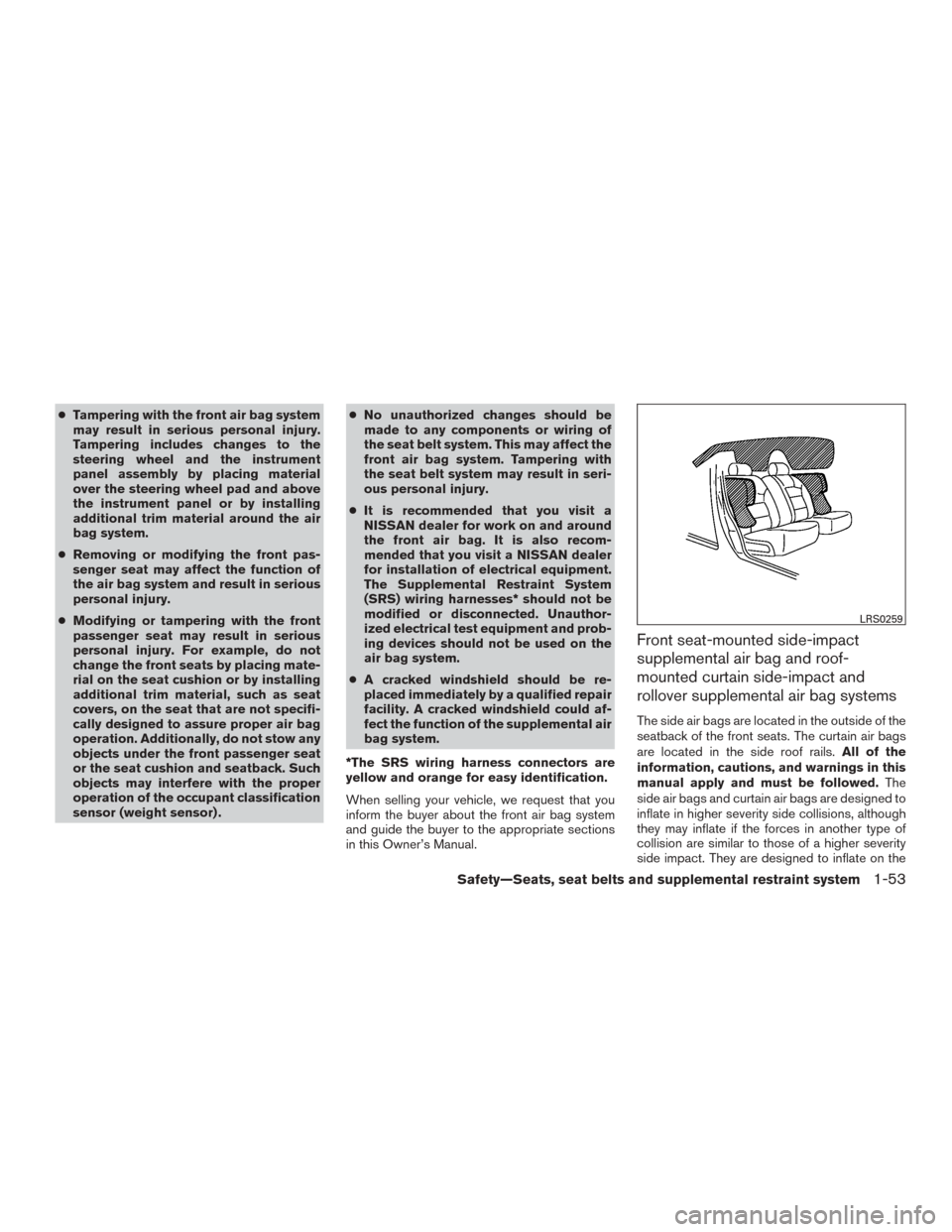
●Tampering with the front air bag system
may result in serious personal injury.
Tampering includes changes to the
steering wheel and the instrument
panel assembly by placing material
over the steering wheel pad and above
the instrument panel or by installing
additional trim material around the air
bag system.
● Removing or modifying the front pas-
senger seat may affect the function of
the air bag system and result in serious
personal injury.
● Modifying or tampering with the front
passenger seat may result in serious
personal injury. For example, do not
change the front seats by placing mate-
rial on the seat cushion or by installing
additional trim material, such as seat
covers, on the seat that are not specifi-
cally designed to assure proper air bag
operation. Additionally, do not stow any
objects under the front passenger seat
or the seat cushion and seatback. Such
objects may interfere with the proper
operation of the occupant classification
sensor (weight sensor) . ●
No unauthorized changes should be
made to any components or wiring of
the seat belt system. This may affect the
front air bag system. Tampering with
the seat belt system may result in seri-
ous personal injury.
● It is recommended that you visit a
NISSAN dealer for work on and around
the front air bag. It is also recom-
mended that you visit a NISSAN dealer
for installation of electrical equipment.
The Supplemental Restraint System
(SRS) wiring harnesses* should not be
modified or disconnected. Unauthor-
ized electrical test equipment and prob-
ing devices should not be used on the
air bag system.
● A cracked windshield should be re-
placed immediately by a qualified repair
facility. A cracked windshield could af-
fect the function of the supplemental air
bag system.
*The SRS wiring harness connectors are
yellow and orange for easy identification.
When selling your vehicle, we request that you
inform the buyer about the front air bag system
and guide the buyer to the appropriate sections
in this Owner’s Manual.
Front seat-mounted side-impact
supplemental air bag and roof-
mounted curtain side-impact and
rollover supplemental air bag systems
The side air bags are located in the outside of the
seatback of the front seats. The curtain air bags
are located in the side roof rails. All of the
information, cautions, and warnings in this
manual apply and must be followed. The
side air bags and curtain air bags are designed to
inflate in higher severity side collisions, although
they may inflate if the forces in another type of
collision are similar to those of a higher severity
side impact. They are designed to inflate on the
LRS0259
Safety—Seats, seat belts and supplemental restraint system1-53
Page 77 of 404
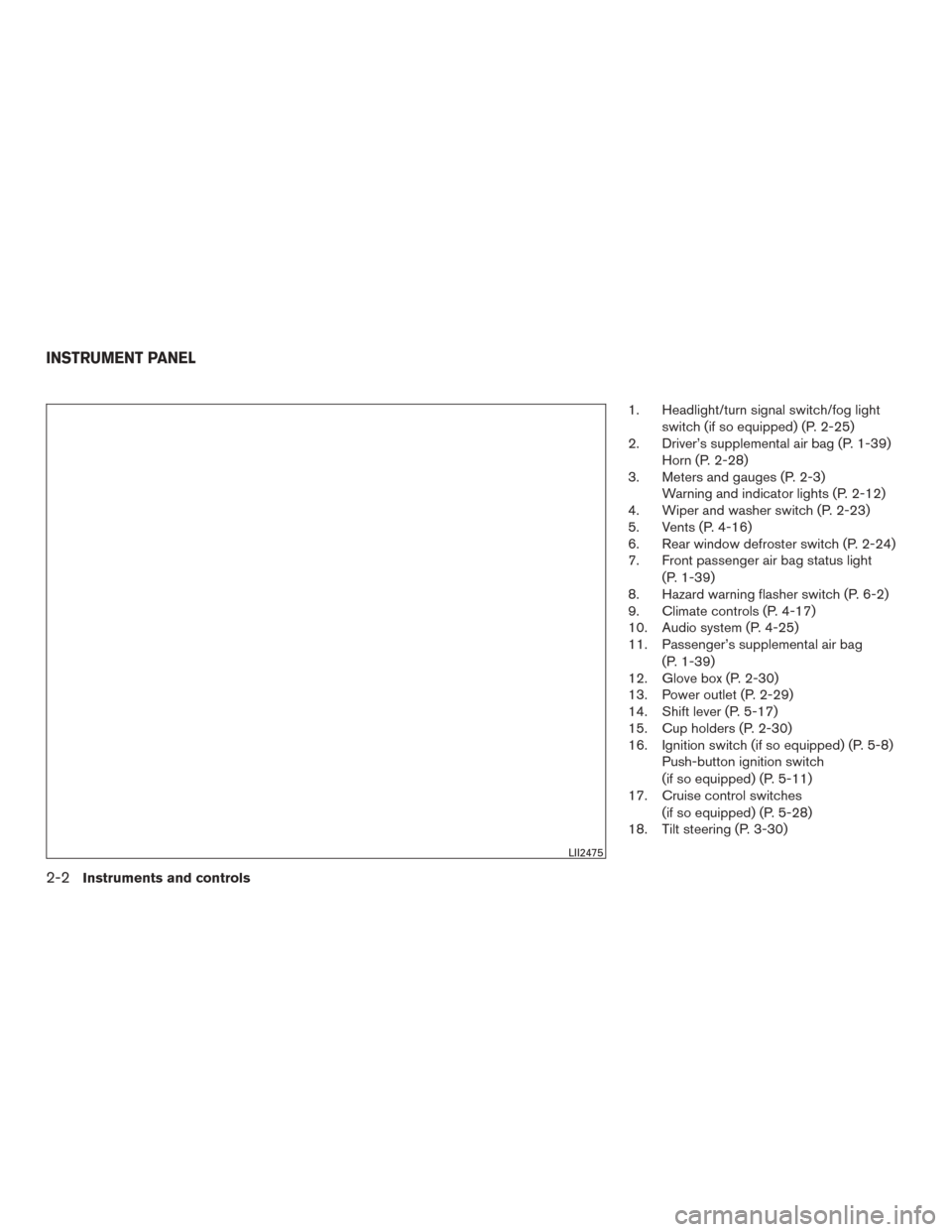
1. Headlight/turn signal switch/fog lightswitch (if so equipped) (P. 2-25)
2. Driver’s supplemental air bag (P. 1-39) Horn (P. 2-28)
3. Meters and gauges (P. 2-3) Warning and indicator lights (P. 2-12)
4. Wiper and washer switch (P. 2-23)
5. Vents (P. 4-16)
6. Rear window defroster switch (P. 2-24)
7. Front passenger air bag status light
(P. 1-39)
8. Hazard warning flasher switch (P. 6-2)
9. Climate controls (P. 4-17)
10. Audio system (P. 4-25)
11. Passenger’s supplemental air bag
(P. 1-39)
12. Glove box (P. 2-30)
13. Power outlet (P. 2-29)
14. Shift lever (P. 5-17)
15. Cup holders (P. 2-30)
16. Ignition switch (if so equipped) (P. 5-8) Push-button ignition switch
(if so equipped) (P. 5-11)
17. Cruise control switches
(if so equipped) (P. 5-28)
18. Tilt steering (P. 3-30)
LII2475
INSTRUMENT PANEL
2-2Instruments and controls